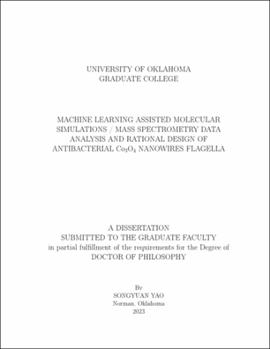| dc.description.abstract | In chapter one, inspired by the recent work from Noé and coworkers on the development of machine learning based implicit solvent model for the simulation of solvated peptides [Chen et al., J. Chem. Phys. 155, 084101 (2021)], here we report another investigation of the possibility of using machine learning (ML) techniques to “derive” an implicit solvent model directly from explicit solvent molecular dynamics (MD) simulations. For alanine dipeptide, a machine learning potential (MLP) based on the DeepPot-SE representation of the molecule was trained to capture its interactions with its average solvent environment configuration (ASEC). The predicted forces on the solute deviated only by an RMSD of 0.4 kcal/mol/Å from the reference values, and the MLP-based free energy surface differed from that obtained from explicit solvent MD simulations by an RMSD of less than 0.9 kcal/mol. Our MLP training protocol could also accurately reproduce combined quantum mechanical molecular mechanical (QM/MM) forces on the quantum mechanical (QM) solute in ASEC environment, thus enabling the development of accurate ML-based implicit solvent models for ab initio-QM MD simulations. Such ML-based implicit solvent models for QM calculations are cost-effective in both the training stage, where the use of ASEC reduces the number of data points to be labelled, and the inference stage, where the MLP can be evaluated at a relatively small additional cost on top of the QM calculation of the solute. (Chapter 1)
In chapter two, we will specifically focus on the pKa values of ionizable residues of pro- teins. As these residues play important roles in protein stability dynamics, aggregation, binding and function [1], it is essential to have an accurate determination of pKa values of
xii
these residues in order to accurately establish protein models in experimental or compu- tational studies. However, pKa value prediction is rather challenging due to many factors such as variable local environment, coupling and interactions among ionizable groups. (Chapter 2)
In chapter three, single-cell mass spectrometry (SCMS) is an emerging tool for studying cell heterogeneity according to the variation of molecular species in single cells. Although it has become increasingly common to employ machine learning models in SCMS data analysis, such as the classification of cell phenotypes, the existing machine learning models often suffer from low adaptability and transferability. To overcome these limitations, here we proposed a meta-learning-based model, MetaPhenotype, for classifying pairs of cell lines (primary and metastatic melanoma). Our results show that, compared to standard transfer learning models, MetaPhenotype can more rapidly achieve a high accuracy of over 90% with fewer new training samples. Overall, our work opens the possibility of accurate cell phenotype classification based on fewer SCMS samples, lowering the demand of training sample acquisition. (Chapter 3)
In chapter four, considerable progress has been made on the synthetic chemistry and an- tibacterial application of tricobalt tetroxide (Co3O4) nanomaterials. However, the current approaches to designing and synthesizing Co3O4 nanomaterials are complicated and hard to manipulate. Herein, we developed a one-pot strategy to synthesize Co3O4 nanowires at room temperature with an antibacterial activity. The synthesis process relied on the use of engineered bacterial flagella as a biotemplate, which were genetically modifiable protein nanofibers naturally attached to bacteria for assisting their swimming. We found that the flagella displaying negatively charged peptides (E10 and E20) effectively induced the nucleation of Co3O4 nanoparticles from a cobalt chloride (CoCl2) precursor solution on their surface to form polycrystalline nanowires, with the E20-flagella being more effective than the E10-flagella. However, the wildtype flagella or those displaying neutral (G10) or positively charged (K5) peptides did not effectively induce the Co3O4 nucleation on the flagella. A mechanism investigation discovered that an amorphous phase of Co3O4 was
xiii
first formed rapidly on the E20-flagella, followed by a crystallization process with both the good crystallinity and nanowire water-dispersibility reached in 2 h. We also found that the E20-flagella formed the Co3O4 nanowires with the good crystallinity at a precursor solu- tion of 1 mM. The E20-flagella-templated Co3O4 nanowires, synthesized using the optimal mineralization conditions (2 h and 1 mM CoCl2) showed the most effective killing of gram- negative bacteria such as Escherichia coli. This work suggests that flagella with tunable peptide sequences are biotemplates for forming antibacterial nanowires at environmentally benign conditions. (Chapter 4) | en_US |

